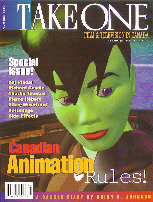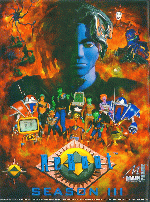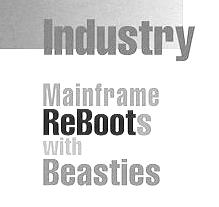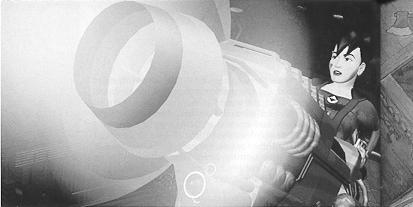
|

|
| Front cover: (90K) Dot above Baudway | Inside front cover: (105K) Season III cast |
Take One is published four times a year by the
Canadian Independent Film & Television Publishing Association.
2255B Queen Street East, P.O. Box 151, Toronto, Ontario, Canada, M4E 1G3.
Phone: (416)535-5244, E-mail: takeone@interlog.com

|

|
| Front cover: (90K) Dot above Baudway | Inside front cover: (105K) Season III cast |


By Mark Freedman
Since its debut in 1994, Mainframe Entertainment's computer-driven ReBoot has consistently been at the top of its ratings time slot, generating an enormous amount of press and numerous awards for its creators, including three consecutive Geminis for best animated program, another Gemini for technical achievement, and a recent Banff Television Festival Rockie nomination for best animation program.
Produced through Mainframe's 40,000 square-foot production facility in downtown Vancouver, the origins of ReBoot actually go back 10 years when Chris Brough (a Canuck working in the Los Angeles film and television industry) was shown a short demo by four animators - Ian Pearson, Gavin Blair, Phil Mitchell and John Grace (collectively known as the 'Hub') - while visiting England. Although primitive in its approach because of software limitations, the demo impressed Brough enough for him to begin the long and difficult process of securing the financing necessary to produce the series.
While Brough worked on the package, members of the Hub kept pushing the envelope with what was then state-of-the-art computer technology. One result was the innovative Dire Straits video 'Money for Nothing,' animated by Pearson and Zondag Entertainment. That video, and subsequent other projects utilizing Computer Generated Imagery (CGI), greatly advanced the possibilities of an animated computer-generated series.
By 1993, all of the pieces had finally fallen into place. High-speed Silicon Graphics workstations and computer animation software had sufficiently developed to make the series technically possible. (It would be improved at Mainframe with proprietary software enhancement programs developed by a team of in-house engineers, mostly graduates from nearby Simon Fraser University.) Brough had convinced the Hub that Vancouver was the only place to produce the first animated CGI series. After one visit, Pearson, Blair and Mitchell agreed.
Financing was put in place with the usual complex and precarious arrangements, typical of Canadian productions. Initially, ReBoot was coproduced by BLT Productions (a successful Vancouver company partnered by Brough and Joanne Lovick that specialized in providing voice talent for animated series) and the U.K.-based Limelight Productions. When Limelight was unable to meet its financial obligations, Toronto's Alliance Communications stepped in and with other parties - ITV in the U.K., ABC in the U.S., Polygram International Video, YTV, Telefilm Canada - the financial picture was complete.
After ReBoot's first season of 12 episodes aired in 1994, 11 more shows were produced in 1995 with additional financing from Alliance, which increased its ownership in Mainframe to more than 51 per cent. It was shortly after this that Disney acquired ABC and ReBoot was quickly dropped from the network. Now sold through syndication, ReBoot ironically has ended up airing on more stations in the U.S. than it ever did on ABC, and it was one of the first syndicated shows the Los Angeles ABC affiliate purchased.
Each ReBoot episode (consisting of over 200,000 frames making up about 31,000 finished images) initially took, on average, 18 weeks to complete. With Mainframe's proprietary software, that number was brought down to less than eight weeks. Although the actual cost of producing a CGI series is comparable to traditional 2-D animated series, the initial capital outlay for equipment and development costs could not be recouped from this one series alone.
In 1996, Mainframe ceased production on ReBoot and co-produced, with Alliance multimedia, the first season of Beasties for Hasbro Toys. [Ed.'s note: The show is known in the United States as Beast Wars, but its Canadian broadcaster, YTV, refused to air a show with the word "wars" in the title.] Based on the popular Transformer toys, this service contract firmly established Mainframe's production capabilities. Proving even more successful than ReBoot's first two seasons, Beasties has been the number 1-rated show in its time slot throughout North America, with its last episodes having the highest viewership ever on YTV.
While negotiating for a second season of Beast Wars, Mainframe has begun to produce a third season of ReBoot, still popular through syndication reruns. Free from network restrictions, the show has evolved, according to Mairi Welman, Mainframe's Director of Communications. "ReBoot will grow up a bit, be slightly darker. Now we are able to do what was originally intended for the show, to be a more grown up, action oriented program." Broken up into a series of four-part related story arcs, this season's first few episodes lie up the loose ends left over from the second season cliffhanger. Only time will tell how audiences will react to this new approach.
In just a few short years, Mainframe has become an important animation company, setting the standard for CGI-series production and enhancing Vancouver's growing reputation as a world-class animation production centre. It's even rumoured to be the object of a possible takeover by Steven Spielberg's DreamWorks, if and when Hollywood's biggest mogul is permitted to set up shop in Canada. With over 170 employees, Mainframe is a rare Canadian success story: instead of exporting our talent, it has brought together talent from Canada, the U.S., and Britain, forming a dynamic company that is producing today's most innovative animated television shows.